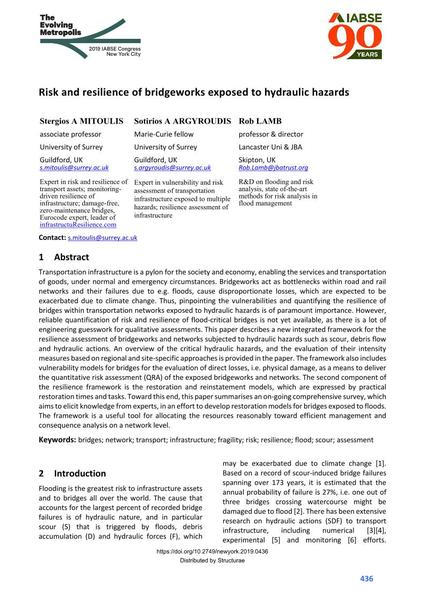Risk and resilience of bridgeworks exposed to hydraulic hazards

|
|
|||||||||||
Bibliografische Angaben
| Autor(en): |
Stergios A. Mitoulis
(University of Surrey)
Sotirios A. Argyroudis (University of Surrey) Rob Lamb (Lancaster Uni & JBA) |
||||
|---|---|---|---|---|---|
| Medium: | Tagungsbeitrag | ||||
| Sprache(n): | Englisch | ||||
| Tagung: | IABSE Congress: The Evolving Metropolis, New York, NY, USA, 4-6 September 2019 | ||||
| Veröffentlicht in: | The Evolving Metropolis | ||||
|
|||||
| Seite(n): | 436-441 | ||||
| Anzahl der Seiten (im PDF): | 6 | ||||
| DOI: | 10.2749/newyork.2019.0436 | ||||
| Abstrakt: |
Transportation infrastructure is a pylon for the society and economy, enabling the services and transportation of goods, under normal and emergency circumstances. Bridgeworks act as bottlenecks within road and rail networks and their failures due to e.g. floods, cause disproportionate losses, which are expected to be exacerbated due to climate change. Thus, pinpointing the vulnerabilities and quantifying the resilience of bridges within transportation networks exposed to hydraulic hazards is of paramount importance. However, reliable quantification of risk and resilience of flood-critical bridges is not yet available, as there is a lot of engineering guesswork for qualitative assessments. This paper describes a new integrated framework for the resilience assessment of bridgeworks and networks subjected to hydraulic hazards such as scour, debris flow and hydraulic actions. An overview of the critical hydraulic hazards, and the evaluation of their intensity measures based on regional and site-specific approaches is provided in the paper. The framework also includes vulnerability models for bridges for the evaluation of direct losses, i.e. physical damage, as a means to deliver the quantitative risk assessment (QRA) of the exposed bridgeworks and networks. The second component of the resilience framework is the restoration and reinstatement models, which are expressed by practical restoration times and tasks. Toward this end, this paper summarises an on-going comprehensive survey, which aims to elicit knowledge from experts, in an effort to develop restoration models for bridges exposed to floods. The framework is a useful tool for allocating the resources reasonably toward efficient management and consequence analysis on a network level. |
||||
| Stichwörter: |
Brücken Infrastruktur Risiko Bewertung Kolk Überschwemmung
|
||||
